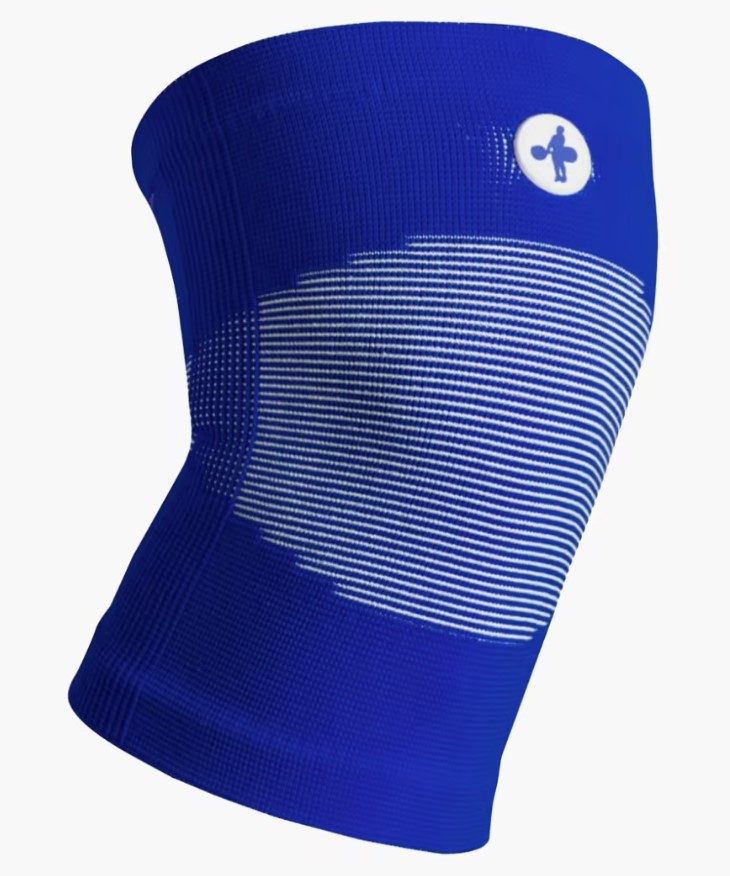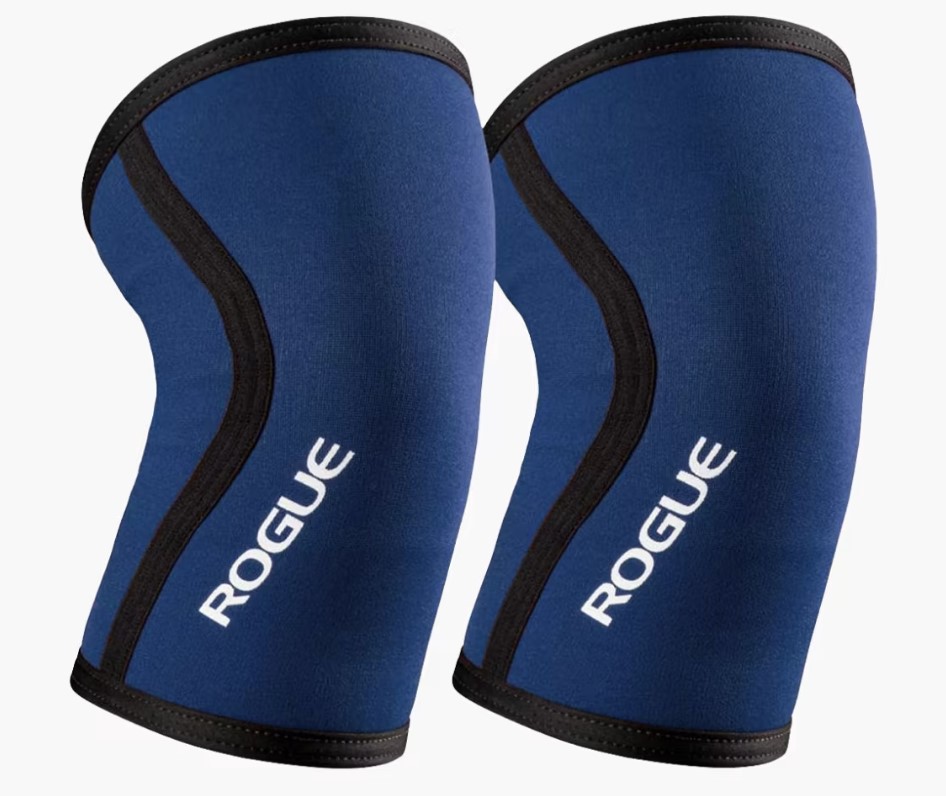Choosing the right knee sleeves can be a daunting task, given the numerous products available. In this blog, we aim to simplify the process by outlining the critical factors to consider, including material, size, and thickness. Additionally, we’ll clarify the distinctions among different knee assistance products and recommend the most suitable knee sleeve for your CrossFit aspirations.
Different knee support products
Knee sleeves, knee wraps, and knee braces are all designed to provide support and protection to the knee joint, but they differ in their construction and the level of support they provide.
Knee sleeves
Knee sleeves are made from a stretchy material and are designed to provide compression and warmth to the knee joint. They are lightweight and flexible, allowing for a full range of motion during exercises. Knee sleeves are often used by athletes as a preventative measure to help reduce the risk of injury and to promote recovery after exercise.
Knee wraps
Knee wraps are made from a stiff, non-stretch material and are designed to provide a high level of support to the knee joint. They are typically used during heavy lifting exercises, such as powerlifting, to help stabilize the knee joint and prevent injury. Knee wraps are wrapped tightly around the knee joint, providing a high degree of compression and support.
Knee braces
Knee braces are designed to provide a higher level of support and protection to the knee joint than knee sleeves or wraps. They are typically made from a combination of neoprene, metal, and/or plastic and are designed to help stabilize the knee joint and reduce pain and swelling. Knee braces are often used by athletes who have suffered a knee injury or who have chronic knee pain.
In summary, knee sleeves provide compression and warmth to the knee joint, knee wraps provide a high degree of compression and support during heavy lifting exercises, and knee braces provide a higher level of support and protection for the knee joint. In this blog the focus is on knee sleeves since those are the best fit for the demands that CrossFit puts on the knee joint.
Materials for knee sleeves
Knee sleeves can be made from neoprene, compression fabrics, or a combination of both. Neoprene is a popular material for knee sleeves because it offers a number of benefits:
- Support: Neoprene is a flexible and durable material that can provide excellent support to the knee joint. This is especially important during exercises that put stress on the knee, such as squats, lunges, and jumps.
- Compression: Neoprene is also a compressive material, which means that it can help to improve blood flow and reduce swelling in the knee joint.
- Warmth: Neoprene is a good insulator and can help to keep the knee joint warm during exercise. This can help to improve flexibility and reduce the risk of injury.
- Moisture-wicking: Many neoprene knee sleeves are designed to be moisture-wicking, which means that they can help to keep sweat away from the skin and reduce the risk of skin irritation.
Knee sleeves made of compression fabrics like nylon or elastane can also be a good option if you are looking to keep the knee joint warm. They will offer little to zero support for the knee joint.
Thickness
Knee sleeves can vary in thickness, with thicker sleeves offering more support and warmth. However, thicker sleeves can also be less comfortable to wear and are more limiting the range of motion. Knee sleeves come in three different thicknesses: 3mm, 5mm and 7mm.
- 3mm knee sleeves are the thinnest and most flexible option. They provide some compression and warmth to the knee joint, but offer minimal support.
- 5mm knee sleeves are slightly thicker and offer more compression and warmth than 3mm sleeves. They can provide some support to the knee joint, but are still flexible enough to allow for a full range of motion.
- 7mm knee sleeves are the thickest and most rigid option. They offer the most compression and warmth, as well as the highest level of support and stability to the knee joint. They are often recommended for heavy lifting and exercises that put a lot of stress on the knee joint.
Some athletes may prefer to use a combination of both 3 or 5mm and 7mm knee sleeves, depending on the activity they are performing. For example, they may use 5mm knee sleeves for exercises that require greater flexibility, and 7mm knee sleeves for exercises that require greater support and stability.
Size
Selecting the right size of knee sleeves is essential for achieving optimal compression and comfort during CrossFit workouts. It’s important to measure your knee circumference and choose a size that fits snugly, but not too tightly. A smaller size can provide greater compression, but it’s important to be aware that the sleeves may slide down during workouts with high repetition squat movements. For CrossFit workouts that involve squat variations, knee sleeves with a snug fit and good placement are recommended. However, for weightlifting or one-rep max squats, a smaller size with more compression can be advantageous
Durability and maintenance
Look for knee sleeves that are durable and can withstand the rigors of CrossFit workouts.
Proper maintenance of your knee sleeves can help to prolong their lifespan and ensure that they continue to provide the support and compression that you need during your workouts. Here are some tips for maintaining your knee sleeves:
- Wash your knee sleeves regularly: It’s important to wash your knee sleeves regularly to remove sweat and bacteria that can accumulate over time. Follow the manufacturer’s instructions for washing, but typically, you can handwash them in cold water with a mild detergent and then hang them to dry.
- Avoid using bleach or fabric softeners: Harsh chemicals like bleach or fabric softeners can damage the neoprene material and reduce the effectiveness of your knee sleeves. Instead, use a gentle detergent and avoid using any harsh chemicals.
- Store them properly: After washing and drying your knee sleeves, store them in a cool, dry place away from direct sunlight. This will help to prevent the neoprene material from breaking down or becoming brittle over time.
- Replace them as needed: Over time, the neoprene material in your knee sleeves may become stretched out or worn, reducing their effectiveness. It’s important to replace your knee sleeves as needed to ensure that you continue to get the support and compression you need during your workouts.
Top choices
3mm and 5mm knee sleeves
If you are looking for 3mm and 5mm you’ll encounter a lot of different suppliers. You can’t go wrong with picking a pair of knee sleeves from Rehband or Rogue Fitness. These two brands have earned a good reputation for durable and high quality products. I own a pair of Rehband RX 5mm knee sleeves myself and after 4 years of wearing them I’m still content with my purchase. The compression does not loosen and there is no wear and tear on the sleeves.
There are a lot of different options if you want to go for a cheaper pair. Make sure to read the reviews of these brands, because cheap is often expensive in the long run.
7mm knee sleeves
The number one choice 7mm knee sleeve for a lot of CrossFit, Weightlifting and Powerlifting athletes are the SBD knee sleeves. The materials are super durable and provide optimal support for your knees. The SBD sleeves are approved by the IPF and IWF for weightlifting competitions. Their only downside is the price, with 75euro per pair they fall in a more expansive category 7mm knee sleeves.

Non-neoprene knee sleeves
One of the better pair of knee sleeves made out of compression fabrics comes from Hookgrip because they offer a snug fit, and can improve blood flow. I personally own a pair of these knee sleeves and they provide a snug fit and keep your knees warm. In terms of sizing, you might want to pick a larger size, because they tend to lower down during workouts.

When (not) to wear knee sleeves
Besides during movements that involve squatting, like wallballs and pistols, there are other instances it can be beneficial (or not) to wear knee sleeves:
- Box jumps: In case you are scared to crack your shines open when doing box jumps, you can slide the sleeves down to your shines and protect them
- Rope climbs: When descending the rope, you will want something to protect the skin around the ankle for nasty burns. Slide down your knee sleeve and use it as a barrier between your skin and the rope
- Snatches: Have you been pulling the bar too hard into your pubic bone when snatching? If your pubic bone feels bruised, you can insert a knee sleeve in the waistband of your pants and protect your cubic bone while snatching
- Double-unders: Avoid wearing knee sleeves when doing double-unders. The compression of the sleeves limits blood flow to the lower legs. This can cause your lower legs to fatigue sooner, because of the restricted blood flow.


Geef een reactie